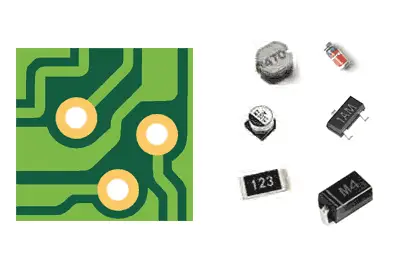We continue to delve into the world of PCBs by looking at some of the frequent electronic components that we will find when designing our PCBs.
In previous posts we have seen the parts of a PCB and the internal structure of a PCB by looking at what PCB layers are, and the differences between PTH and SMD components.
By now we should be very clear that a PCB is a simple and compact way to make electrical connections, replacing traditional cables. But, by itself, a PCB is not very useful (or rather not at all).
A PCB needs components to form an electronic circuit and perform the action for which it was designed. Therefore, the components mounted on the PCB are equally (or more) important during the PCB design process than the PCB itself.
Given the importance of the components, we couldn’t have a section on PCB design without briefly looking at some of the types of components that we will commonly find when creating or reviewing PCB schematics.
We emphasize “briefly” because, of course, there is an almost infinite number of components and models. It would be impossible to create and maintain a list with all of them. But, at the very least, it is interesting to make a list by way of introduction, with some basic components and their usual models in the domestic and maker environment.
Here we clarify again that by “usual”, we mean that you can easily and cheaply find them from sellers like eBay or AliExpress. This does not mean (by any means) that it is the best model or the most used in the professional environment. But you will encounter them frequently.
Of course, most of these components will be available in both PTH and SMD formats, although in this post we will pay more attention to SMD models. And finally, we can start to see our list of common components in PCB designs.
Passive Components
Resistors
The most common passive component in any electrical circuit. As representatives of Ohm’s Law, their function is to establish a relationship between electrical current and voltage. It’s hard to imagine a PCB without any resistors.
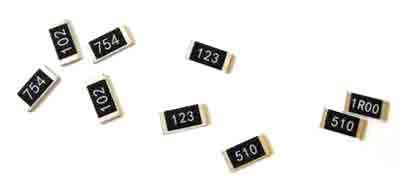
We can find SMD resistors between 10R to 910K, in different sizes, formats, and power ratings.
Capacitors
Another basic passive element in any PCB. The variation (derivative) of the voltage in a capacitor is equal to the current that flows through it. Capacitors are frequent components in filtering, signal decoupling. We can find SMD capacitors compatible with voltages up to 6V, 6.3V, 10V, 16V, 25V, 35V, 50V.
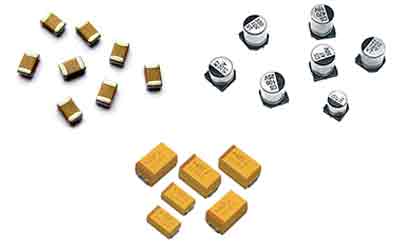
Ceramic capacitors provide ranges from 270pF to 47uF. For higher capacitances, we have electrolytic capacitors from 22uF to 470uF (be careful, they are polarized). Finally, we have compact but expensive tantalum capacitors that are easily available for 10uF to 470uF.
Inductors
The third and last passive component. In inductors, or coils, the variation in current is equal to the voltage, with their behavior being opposite to that of capacitors. Their use is less frequent in initial level circuits, but they are widely used for filtering, voltage changes, and creating oscillator circuits.
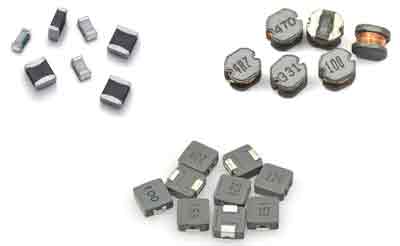
You can find them in ceramic formats for inductances from 1uH to 100uH. For higher inductances, we have SMD coil cores from 2.2uH to 470uH.
Diodes
An electronic component that has a much higher resistance to the passage of electricity in one direction than in the other.
Rectifiers
They are low-speed diodes with high current values. They are widely used in power applications, such as AC-DC converters, rectifiers, or flyback diodes to protect electronics from inductive loads.
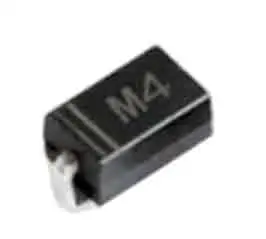
The popular 1N400x series (or Mx) is widely used for different voltages up to 50V (1N4001 M1), 400V (1N4004 M4), and up to 1000V (1N4007 M7). They are not suitable for applications above 10 KHz. They have a voltage drop of 0.7V.
Zener
It is a heavily doped silicon diode designed to work in the reverse zone. Its main function is that, when polarized in reverse, they impose a constant and almost invariant voltage to load or temperature variations. They are a fundamental part of voltage regulators, voltage references.
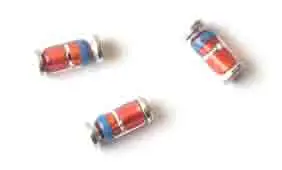
There is a wide variety of models with similar characteristics, but we will mention the 1N4148 LL34 of 1/2W, available for reverse voltages from 3V to 24V.
Schottky
A diode that replaces the P-N semiconductor junction with a semiconductor metal junction. Its main function is to provide fast switching speed and lower voltage drop. As a disadvantage, they have a lower current carrying capacity and support lower reverse voltages.
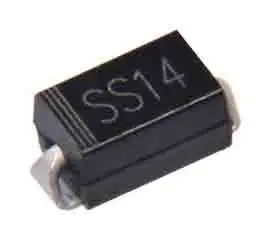
For example, the Schottky diode SS14 1N5819 is common.
LED
Well known by all, a Light Emitting Diode is a diode in which the change in the state of the electrons is used to emit light. Available in different sizes and colors, which are determined by the voltage drop for which it is designed.

Varistor
A variable resistor is an electronic component whose resistance decreases as the applied voltage increases. They are frequently used as surge voltage limiters.
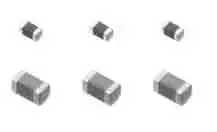
They have a fast response time (5-25ns) and can be found for voltages from 14V to 550V. As a disadvantage, they degrade with use, so they have reduced reliability.
Crystals
Crystals or resonators are used to generate frequencies, which are then used by other devices such as processors. We can find them between 3.2 MHz and 400 MHz.
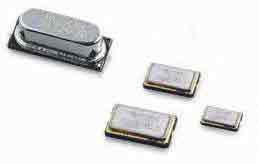
Transistors
Probably the most important electronic devices, and old acquaintances of the blog. As we know, their main use is as amplifiers or as electronic switches.
BJT Transistors
Among NPN transistors, the 2N3904 for a voltage of 40V and 0.2A is common, and its larger sibling, the very popular 2N2222 for 40V and up to 1A.
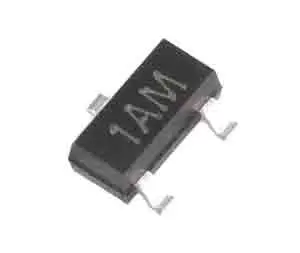
In PNP format, we have the equivalents 2N3906 of 40V and 0.2A, the 2N2905/2N2907 for 40V and 0.6A, as well as the BC807, for 45V and 0.5A.
MOSFET Transistors
In N-channel Mosfet transistors, the AO3402 A29T is very popular, for 30V and up to 4A.
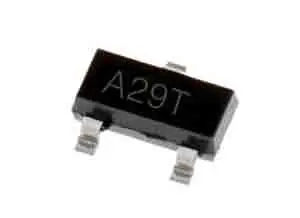
In P-channel, we have its equivalent AO3401 A19T for 30V and up to 4.2A. The more economical AO3413 for 20V and up to 2.4A is also common.
Other Integrated Circuits
Voltage Regulators
As the name suggests, they are used to establish a constant voltage that we will use, usually to power a device or use as a reference.
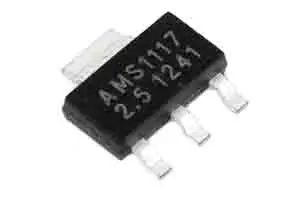
The 78M05 or L78M05 for up to 0.5A are common. The LM1117/AMS1117 and similar are also popular, for up to 1A. Finally, the LM317 (LM317D2, LM317D2T…), for up to 1.5A.
Operational Amplifiers
A widely known component, a Swiss army knife of electronics that serves not only to compare voltages but can also be used in amplifiers, summing amplifiers, integrators…
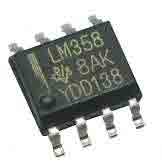
A very common operational amplifier is the LM358, as well as the popular NE5532, the LM1458, or the TL072 family.
Optocoupler
Used to connect two electronic parts while maintaining galvanic isolation between them, for which they use light to transmit information.
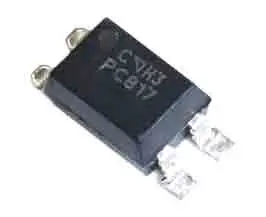
Here we find the popular PC817 and similar (PC817/C, EL817C, …)
Other Components
Fuses
Protection elements for our circuits. We find breaking fuses, which interrupt the service when a certain current passes through them, or thermal fuses that interrupt the service when they exceed a certain temperature for a certain time.
Microswitches
Also known by all, a switch, but tiny. Some are maintained action (properly a switch) and others are momentary action (push-button), which in turn can be normally open or closed.
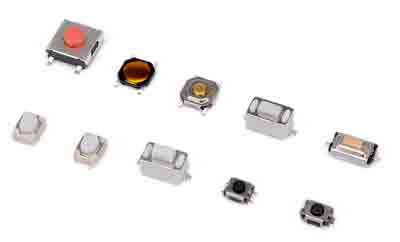
It is worth noting the SPDT (single pole, double throw) devices, which are switches that have at least 3 pins, and by acting on them we can choose more than one option.
Connectors
Connectors are another typical component of a PCB, and there are so many that it would be enough for their own entry. So we limit ourselves to mention them and indicate that it is the way to make the cable connections that we need for our PCB.
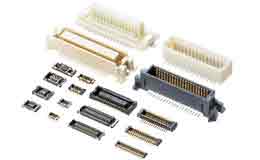
Conclusion
We have made a mini summary of some of the main types and families of components that we will find when creating or analyzing the design of a PCB, so that they sound familiar to us and we can identify them.
Of course, as we said, there are thousands and thousands of types, both in SMD and PTH. But these are some of the usual ones, because they are easy and cheap to buy. So we will also find them.
Of course, we can also find them in a wide variety of sizes. This, precisely, we will dedicate the next entry to. See you soon!
